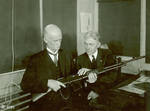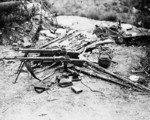Browning Automatic Rifle M1918 'BAR' Machine Gun
| Country of Origin | United States |
| Type | Machine Gun |
| Caliber | 7.620 mm |
| Capacity | 20 rounds |
| Length | 1.214 m |
| Barrel Length | 610.000 mm |
| Weight | 9.980 kg |
| Rate of Fire | 550 rounds/min |
| Range | 548.000 m |
| Muzzle Velocity | 805 m/s |
Contributor: C. Peter Chen
ww2dbaseThe Browning Automatic Rifles, often referred to as "BAR", were a series of automatic rifles that began with the original design by John Browning in 1917. They were gas-operated and air-cooled. They first entered service in the United States Army in Feb 1918 in the midst of WW1, with the concept that they could be used by moving infantrymen to lay down fields of suppressive fire as other riflemen rushed from one trench to the next. However, partially due to their late entry into war, factored in with the US Army's reluctance to risk German capture of this new weapon, Browning Automatic Rifles actually saw little service during WW1. They were first used in battle in Sep 1918. Only 85 units of the Browning M1918 series were built by end of the war.In 1922, the Browning M1922 was introduced as "machine rifles". They had flanged or finned barrels and side-mounted sling swivels, and were intended for use by the US Army cavalry units. The flanges/fins improved cooling properties, but also added to the weight.
In the 1920s, the Belgian firm Fabrique Nationale acquired a license to build M1918 Browning Automatic Rifles. Before the Belgian models entered production, Fabrique Nationale already entered its version of the Browning Automatic Rifle into a Polish contest; Fabrique Nationale came out victorious over competitors Lewis and Hotchkiss. The Polish Army rushed to designate their new license of light machine guns the Browning wz.1928, but production for both Belgian and Polish models did not start until 1930, leading to the Belgian designation of these weapons as the FN M1930. The Belgian and Polish variants of the BAR featured pistol grips as opposed to the rifle stock grips seen in the original American design, and they were re-chambered to use the 7.92x57-mm Mauser rounds. Both designs were slightly shorter than the original American versions (1,110-mm), but were slightly heavier. Some Belgian variants, designated Type D, also featured a quick-change barrel. Between 1930 and 1939, approximately 14,000 Browning wz.1928 automatic rifles were built by Poland; they served as the standard light machine guns of the Polish Army that defended against Russo-German joint invasion of Sep 1939. Over 10,000 FN M1930 automatic rifles were built.
During the inter-war period, a number of M1918 BARs were built in the United States and sold to Sweden. Designated Kulsprutegevär m/21 and m/37, they had detachable pistol grips, spiked bipods, and were re-chambered to use the 6.5x55-mm Swedish Mauser rounds. Later, they were built in Sweden locally under license by Carl Gustafs Stads Gevärsfaktori in Eskilstuna, Sweden. The m/37 model featured a quick-change barrel.
In Jun 1937, a small number of US Army M1918 BARs were redesignated as M1918A1 after adding spiked bipods and hinged buttplates.
After the German invasion of Poland in Sep 1939, a few Polish BARs were captured. They were pressed into German service under the designation of IMG 28 (p). A few were also captured by Russians and later used against the Germans.
In 1940, M1918A2 BARs were introduced into the US Army. The major change with the new model was that there would be no more semi-automatic firing mode; the new BARs would be fully automatic with adjustable rates of fire. The two settings were "fast-automatic" at 500-650 rounds per minute or "slow-automatic" at 300-450 rounds per minute. Other changes include the addition of unspiked detachable bipods, flash hiders, and hinged rear monopods. As fully automatic weapons, an idea to make Browning Automatic Rifles the standard light machine gun at the squad level was entertained, but it was never implemented as there were purpose-built light machine guns available that performed better in that role. Nevertheless, all men were trained on the operation of the Browning Automatic Rifles. Soldiers tend to regard BARs as reliable and effective despite problems such as difficulty in cleaning which led to jams and frequent overheating due to thin barrel diameter. The use of particular metals in the BARs also led to a higher rate of corrosion in the humid South Pacific.
In 1942, fiberglass/plastic buttstocks were introduced as a weight-savings measure. In 1944, a barrel-mounted carrying handle was added to improve portability.
M1918A2 Browning Automatic Rifles remained in US Army service through the Korean War. They were also seen during the Vietnam War, though US Army use of them by then was already on the decline, though the South Vietnamese Army deployed them in quantity. The US Army National Guard continued to use them until the mid-1970s. Swedish m/37 model BARs remained in use until the 1980s. Around the world, they remained in military use as late as the 1990s. A few civilian variants were built after WW2.
Source: Wikipedia. ww2dbase
Last Major Revision: Dec 2007
Browning Automatic Rifle M1918 'BAR' Machine Gun Interactive Map
Photographs
 |  |  |  |
Please consider supporting us on Patreon. Even $1 per month will go a long way! Thank you. Please help us spread the word: Stay updated with WW2DB: |
Visitor Submitted Comments
2. gab says:
12 Oct 2009 01:17:54 PM
can somebody help me? i have found a B.A.R. in an antic store and i dont know what to look for to see if it is in good condition(besides the obvious rust ect.. mostly the inside components)
12 Oct 2009 01:17:54 PM
can somebody help me? i have found a B.A.R. in an antic store and i dont know what to look for to see if it is in good condition(besides the obvious rust ect.. mostly the inside components)
3. Anonymous says:
4 Mar 2010 06:09:33 PM
if someone is selling aBBAR iwill buy it for $1000
4 Mar 2010 06:09:33 PM
if someone is selling aBBAR iwill buy it for $1000
4. Paul Robertson says:
14 Jun 2010 06:02:29 AM
How do you install the mainspring into a BAR?
14 Jun 2010 06:02:29 AM
How do you install the mainspring into a BAR?
5. Anonymous says:
7 Oct 2012 11:49:53 PM
Is it possible to find old B.A.R.s in a WWII battlefield?If so, what condition would it most likely be in?I'm not an expert on how the materials used in the riffle would age if they were just left alone in the woods since WWII, but I'm assuming that the wooden stock would most likely be gone.Any way to replace that?
7 Oct 2012 11:49:53 PM
Is it possible to find old B.A.R.s in a WWII battlefield?If so, what condition would it most likely be in?I'm not an expert on how the materials used in the riffle would age if they were just left alone in the woods since WWII, but I'm assuming that the wooden stock would most likely be gone.Any way to replace that?
6. The Didiler Gillet PART 2 says:
22 Feb 2016 08:58:18 AM
oh yes this is quite the article and i have swallowed a lot of knowledge about this. The publisher has studied up boys!
22 Feb 2016 08:58:18 AM
oh yes this is quite the article and i have swallowed a lot of knowledge about this. The publisher has studied up boys!
7. Anonymous says:
14 Apr 2016 11:17:25 AM
how many people used it in WW 1
14 Apr 2016 11:17:25 AM
how many people used it in WW 1
8. 2623c says:
28 Apr 2016 11:20:37 AM
How much, please, do the leather spare parts wallet, oiler and cleaning rod case (all with contents) weigh?
28 Apr 2016 11:20:37 AM
How much, please, do the leather spare parts wallet, oiler and cleaning rod case (all with contents) weigh?
9. Anonymous says:
27 Nov 2017 08:24:53 AM
Why is this sourced from Wikipedia?
27 Nov 2017 08:24:53 AM
Why is this sourced from Wikipedia?
10. Anonymous says:
24 Jan 2022 02:08:40 PM
Hi....What is the outside measurement of the barrel of a B A R Rifle ?....thanks
24 Jan 2022 02:08:40 PM
Hi....What is the outside measurement of the barrel of a B A R Rifle ?....thanks
All visitor submitted comments are opinions of those making the submissions and do not reflect views of WW2DB.
Search WW2DB

News
- » The Emperor of Japan Planned to Honor WW2-era Japanese POWs in Mongolia (4 Jul 2025)
- » US State Lawmaker John Winter Caught Using Racial Slur "Jap" and Apologized (11 Jun 2025)
- » Köln/Cologne Evacuated After Discovery of WW2 Bombs (4 Jun 2025)
- » Race, Holocaust, and African-American WW2 Histories Removed from the US Naval Academy Library (7 Apr 2025)
- » US Government Plans to Purge WW2 Information (17 Mar 2025)
- » See all news
Browning Automatic Rifle M1918 'BAR' Machine Gun Photo Gallery
 |
Current Site Statistics
- » 1,178 biographies
- » 337 events
- » 45,089 timeline entries
- » 1,245 ships
- » 350 aircraft models
- » 207 vehicle models
- » 376 weapon models
- » 123 historical documents
- » 261 facilities
- » 470 book reviews
- » 28,488 photos
- » 365 maps
Famous WW2 Quote
"Goddam it, you'll never get the Purple Heart hiding in a foxhole! Follow me!"Captain Henry P. Jim Crowe, Guadalcanal, 13 Jan 1943
Support Us
Please consider supporting us on Patreon. Even $1 a month will go a long way. Thank you!
Or, please support us by purchasing some WW2DB merchandise at TeeSpring, Thank you!
6 Jan 2008 11:32:32 PM
Sirs,do you know if one FMBAR A2 number 845xxx are a WWII serial or a Korean War ? thank for your help